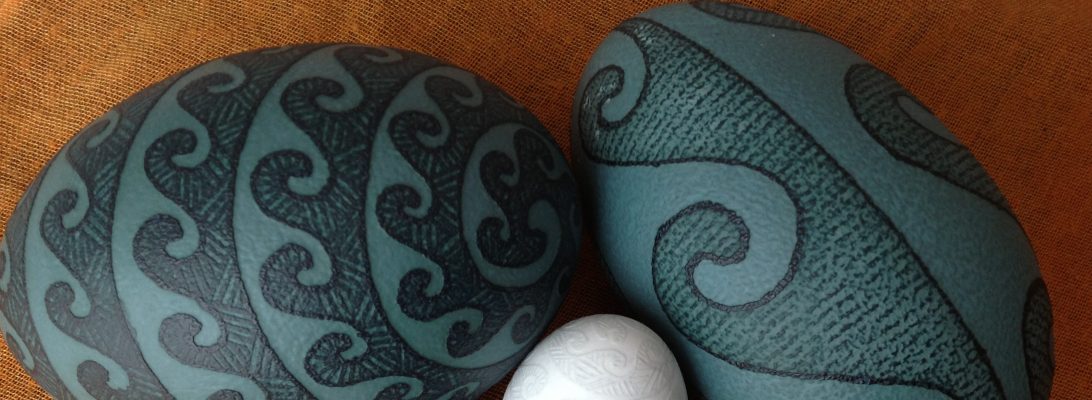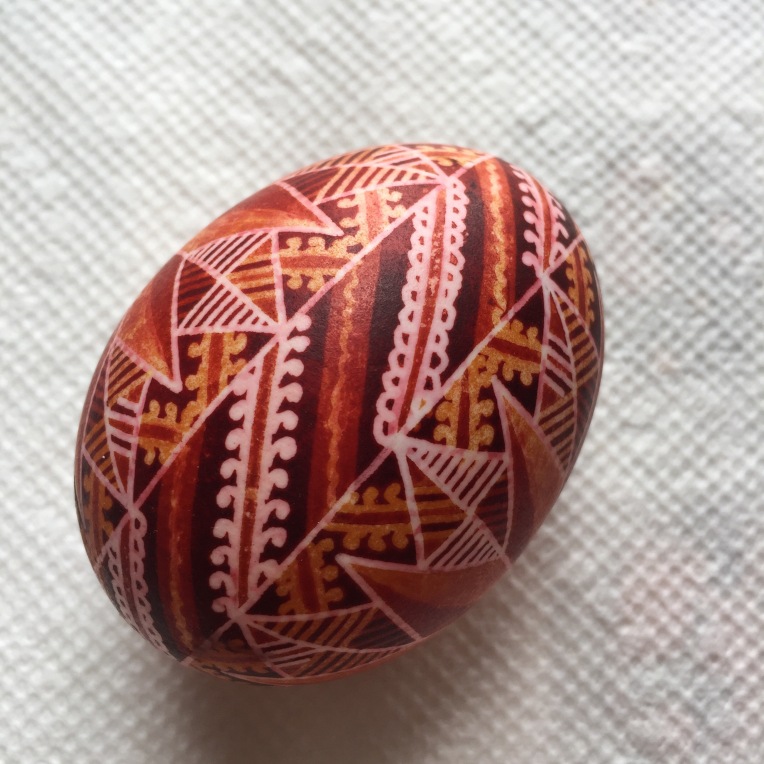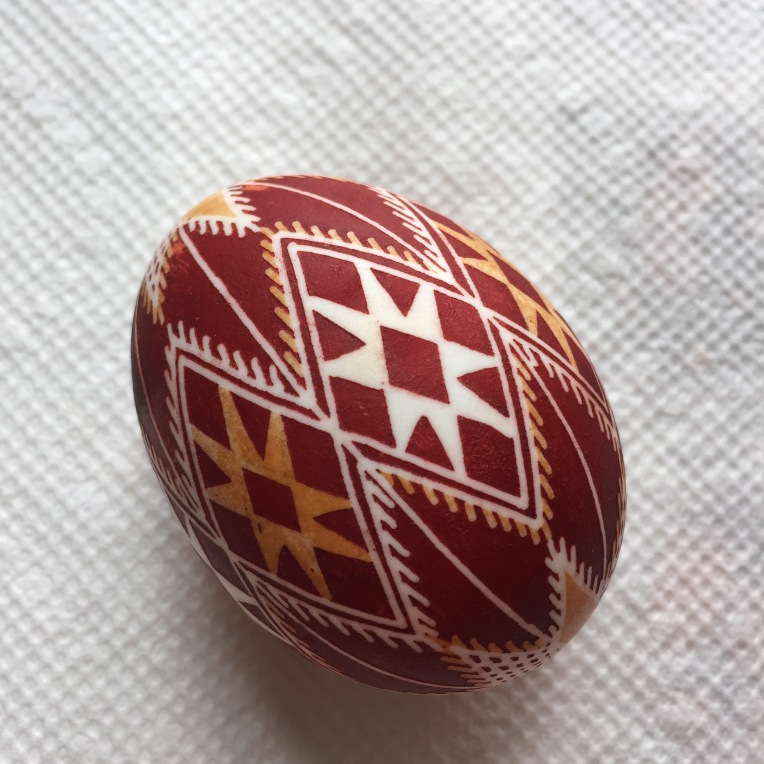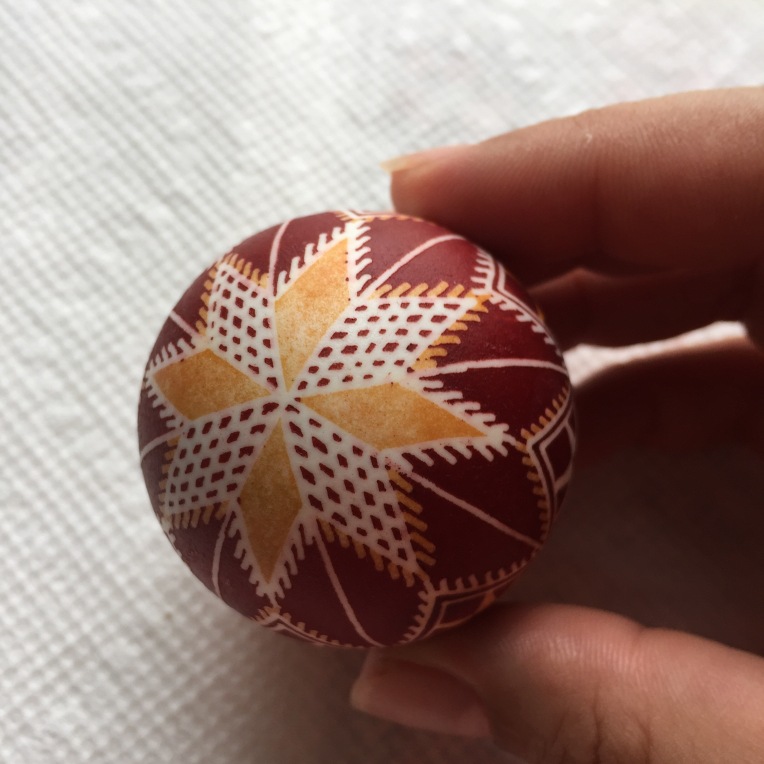Here is the result:

You already saw the previous post with yellow coreopsis dye. I must say this was my favourite dye, and I was extremely lucky to have started with it, because I have struggled quite a bit with the next dyes. Coreopsis give a good intense yellow with relatively little dye, without cooking (just boiling water), it dyes quite fast and works well for a long time. While the red dyes have spoiled by now, this one seems fine still, and smells as beautifully now, as it did in the beginning, in spite of having been sitting in a jar in a hot room. I love this dye and will definitely keep using it.
Now, one by one.
1. coreopsis – yellow, madder standard and cochineal – red (50-50 mixture, twice).

I would have probably dyed it for the third time, the plan was to leave it in the dye over night one more time (it had already a session of few hours and then once overnight), because it still had some patches not fully dyed to my liking, but when I came from the week-end of being away, the dye has spoiled, so I’ll have to try a new batch of red dye eventually. I have really struggled with both madder and cochineal, I was not getting the intensity of color that I was expecting based on other people’s reports (and probably based on my amazing experience with coreopsis), I have used up the small container of madder standard in the process. I still have a container of madder rich, but that has turned from powder into a piece of rock, so I’ve let it be for now. I am tempted to just buy some regular madder in a herb store – it comes both in the root form and in powder, and see whether it works better that this fancy dye powder. We’ll see.
2. red cabbage – teal, vinegar – white.

Red cabbage was a nice experiment, because that is something that is easily available in a grocery store. I did add a mordant, and changed the pH balance to have a blue tone instead of purple. It smells like cabbage, is rather weak when dyeing, and takes a while, but still it works, and let’s see how the color withstands time and light. Maybe I’ll show later in a separate post and in detail, how I made that dye, especially if I manage to get another egg or two dyed in it.
3. coreopsis – yellow, black walnut – brown. Goose egg.

Black walnut worked sort of OK, but took a while to dye. It’s good as foundation (or over-dye) for other colours to make them darker. Perhaps I should have dyed this one two or three times. The dye powder is coarser than others, and I have more of it, so I will likely play with it a bit more, to see whether I can get the color more intense or have it dye faster. The egg pattern is not traditional, it is from a memorized and partially improvised version of a trypillya-style egg I have seen before. Not sure who is the author of this pattern, if I knew I would say.
4. black walnut – brown, vinegar – white.
I did an experiment here, because this was an etched egg and I did not want to mess up the while background by taking the wax off with the candle, I did half of it with hot water and half with hot oil. Turned out, walnut did not like one of those procedures (neither, by the way, did the etched cabbage egg above), guess which was the procedure not liked by walnut and cabbage? You can see that the dye on the right (or bottom) half of the egg has partially washed away. Didn’t like the water, liked oil just fine. You’ll see later that lac did not like oil. But maybe would not have liked water even more, who knows…

5. coreopsis – yellow, red cabbage – pale green, lac and then black walnut – brown.
This is the egg from the previous post.

So the red cabbage gave this pale green instead of teal-blue after coreopsis. I fell in love with this pattern earlier this year, so here is a comparison, the same pattern dyed with chemical dyes, with natural dyes and without dyes – etching with vinegar on the brown egg.

6. coreopsis – yellow, madder and cochineal – red, lac – burgundy, vinegar – white.

In the photo below you can see that lac was not happy at all and came off with the wax. Not sure whether it did not like the hot oil, which I used to take it off, or maybe it was just generally unhappy. It did not behave like this in the egg above when I used black walnut over lac, maybe this is what I should have done here. But, in general, lac stinks (worse than cabbage), it takes a long time to dye, the color is not particularly nice, and as we can see, does not stay so well. And it spoiled also within the same timeframe as madder+cochineal. I still have some left, so I might do more research to see whether I can add something to the dye to make it more happy (chalk? cream of tartar? something else?) and play more with it, but probably not any time soon. I will probably try out other versions of similar colours that I have not tried yet before coming back to this one.

See, this is lac by itself, the first try on plain egg – I should have known still from this first run, that is does not stick all that well to egg, the dye came off just by me wiping the egg dry.

So, that’s it for now. Ask questions if you have any.
All the dyes I have used here besides red cabbage are Maiwa extracts in powder form.

 These are iron, vinegar and alum. Soda didn’t really work much at all, so it’s not in this picture. Then I added alum into both vinegar and soda jars, to see whether that would improve how the color took. Left the one in just alum and vinegar+alum for another hour to achieve one more shade, left the rest for the night. Here is before taking the wax off, iron, vinegar, alum, soda (that one didn’t change at all after adding alum, and did not give a darker shade overnight, vinegar improved with alum, but the dye didn’t adhere so well to the egg):
These are iron, vinegar and alum. Soda didn’t really work much at all, so it’s not in this picture. Then I added alum into both vinegar and soda jars, to see whether that would improve how the color took. Left the one in just alum and vinegar+alum for another hour to achieve one more shade, left the rest for the night. Here is before taking the wax off, iron, vinegar, alum, soda (that one didn’t change at all after adding alum, and did not give a darker shade overnight, vinegar improved with alum, but the dye didn’t adhere so well to the egg):

























